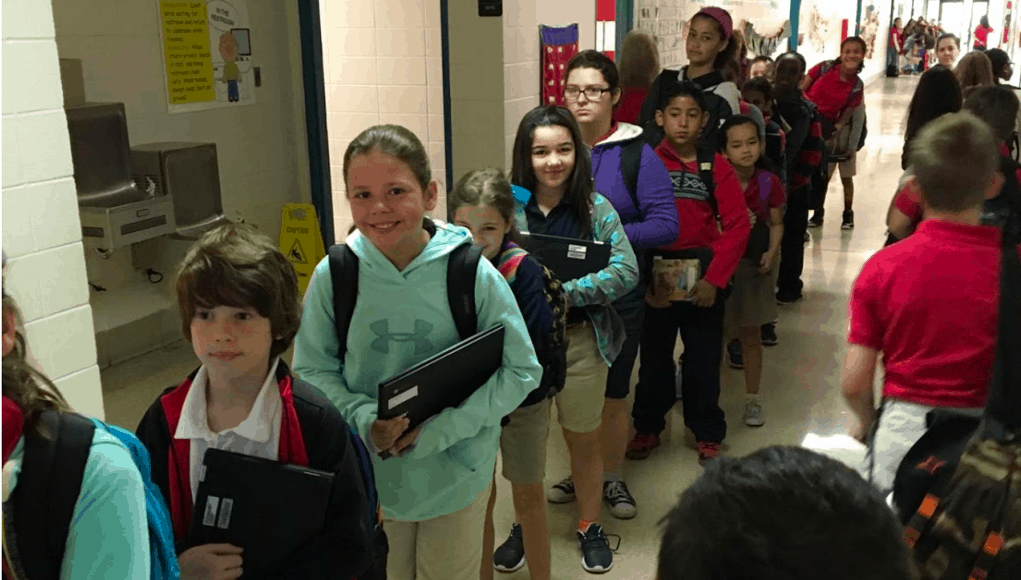Improving Connectivity to Create Powerful Learning Experiences

By LaShona Dickerson
Lafayette Parish School System is the sixth largest district in Louisiana, serving six cities within the parish (county) and more than 31,000 students. Providing connectivity to so many students at peak times was strenuous on our network. It was outdated, a network built for the past.
I found it very unsettling, upon accepting this leadership role in the district, that during months (yes, months) of testing, we had to throttle back on streaming services to ensure adequate bandwidth for statewide online assessments–what an impairment to learning! I knew something had to change.
Online test platforms were growing faster than I could say “test” and bandwidth was stagnant and practically unusable. Teachers were competing for online time in school computer labs. All of this was negatively affecting learning environments, and instructional time lost to and from labs was an added frustration for teachers.
With a one-time funding opportunity for online testing equipment, this was our chance to heal an ailing infrastructure and network. We set out to designate spaces within each school as mobile testing labs. Those “mobile testing labs” were equipped with appropriate desks, two wireless access points and a cart of at least 30 laptops. At this point, we were still not par for the network course. Testing was done, but learning was still suffering.
Finding The Solution
At the foundation was our “Vision 2020, Transformational Change Through Technology” initiative. With this mission, we wanted to achieve complete 1:1 implementation and move our district’s textbooks online by 2020. By achieving this, our students would be able to utilize technology in some of the most influential ways possible.
The E-Rate Modernization and the Broadband Initiative were lifelines to resuscitating our network. Like beacons of light, we gravitated to the guidelines of these programs. We set our sights on bolstering bandwidth in all of our buildings. Now we had a target and the opportunity for a substantial amount of funding to invest in building the infrastructure we needed for continuous learning.
The federally funded E-rate program provides discounts to schools and libraries so they can gain access to vital telecommunications and internet services. Applying for and obtaining E-rate funding is a process that requires diligence, patience and expertise, so we asked e-rate consultants Funds For Learning to help us out.
Because of the funding we received, we’ve secured 10GB fiber connectivity in all 43 of our school sites and wireless access points in every classroom. This means teachers no longer have to choose between instruction and online assessments. They no longer have to scramble for computer lab space and we do not have to throttle back connectivity during testing. They can focus on students rather than troubleshooting connectivity issues. The E-rate program helped transform our schools, and now because of it, we are able to plan and begin execution of a 1:1 initiative.
Lessons Learned
We learned some hard lessons as we were getting our “Vision 2020, Transformational Change Through Technology” initiative off the ground. As more schools and districts across the U.S. strive to upgrade technology and connectivity, here are some tips our team learned:
1. Start with infrastructure. It’s tempting to go straight for the devices, to invest in scores of laptops, tablets or mobile devices that give students access to digital learning opportunities. The fact is, unless there’s enough bandwidth to support the devices, they can be more of a hindrance than an advantage. Focus on connectivity first.
2. Find a partner. Big initiatives are never easy. Change is fought with uncertainty, hiccups and sometimes skepticism. For us, Funds For Learning became part of our district community and family. In addition to bringing expertise and know-how, good partners offer moral support and reassurance when challenges arise.
3. Get creative with funding. Limited resources, both in terms of staff and budget, often threaten to derail even the most carefully hatched plans. Drawing funding from a variety of diverse sources can protect your initiative in case a major funding stream dries up. The predictability of E-rate funding allowed us to push our initiative forward with confidence.
The progress Lafayette Parish Schools has made over the last two years still amazes me. It’s a credit to our supportive community and dedicated teachers. But our school system isn’t unusual; with the right combination of planning, ambition and perseverance, districts across the U.S. can achieve similar results.
For more, see:
- 10 Strategies Promoting Digital Access and Equity
- Making Technology Just and Equitable
- Getting Smart Podcast | Google’s Jaime Casap on Inequity and Inquiry
LaShona Dickerson is the technology director at Lafayette Parish Public Schools in southern Louisiana. Follow her on Twitter: @Shona_Dee620
Stay in-the-know with all things EdTech and innovations in learning by signing up to receive the weekly Smart Update.






0 Comments
Leave a Comment
Your email address will not be published. All fields are required.